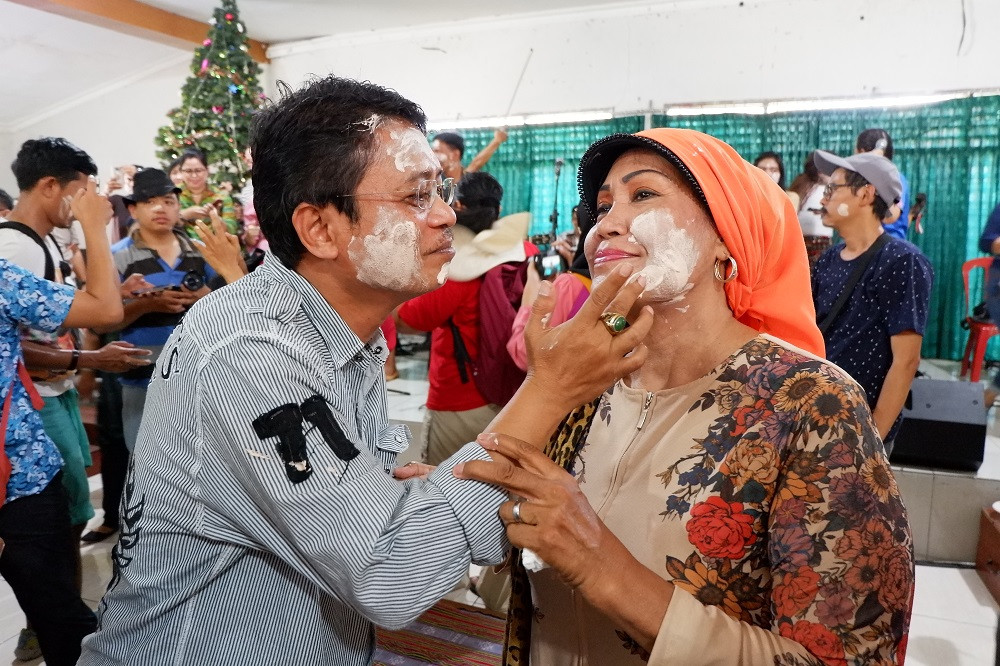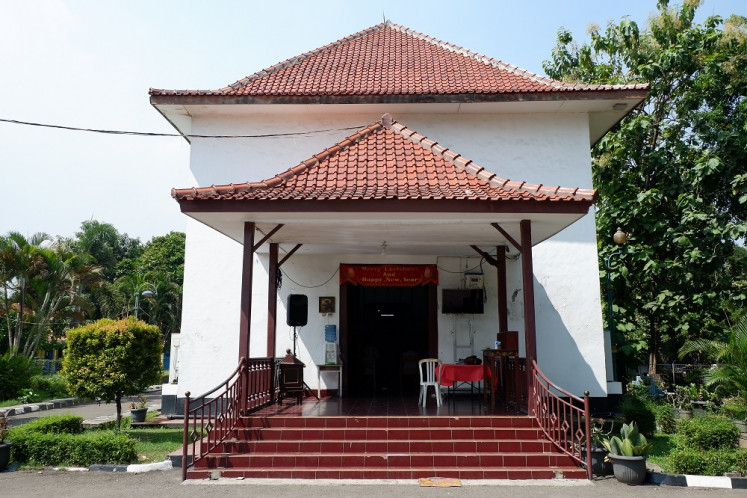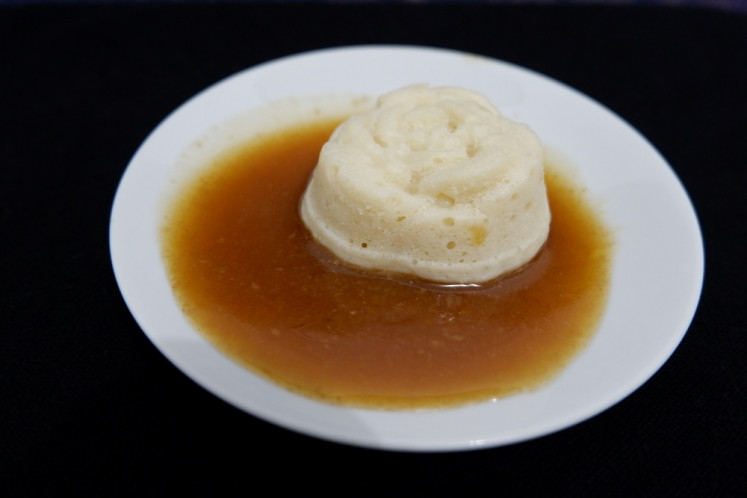Popular Reads
Top Results
Can't find what you're looking for?
View all search resultsPopular Reads
Top Results
Can't find what you're looking for?
View all search resultsKampung Tugu: Hidden portuguese gem in North Jakarta
Rabo-rabo is a tradition of Indonesians of Creole Portuguese descent in Kampung Tugu.
Change text size
Gift Premium Articles
to Anyone
F
or Indonesians of Portuguese descent living in the 358-year-old Kampung Tugu, New Year’s Day is like the Muslims’ Idul Fitri.
The sun was scorching hot and Erni Michiels sang “Buka Pintu” (Open the Door), a traditional Moluccan song, on the way to her nephew’s house, Arthur James Michiels, in Kampung Tugu, North Jakarta, on Jan. 1.
That day, trucks and containers were also bustling near Kampung Tugu, but Erni made sure she dressed properly and did not let the dust from the large vehicles stop her to look like a million dollars.
Clad in a bright red kebaya dress, the 65-year-old was tailed by her neighbors, with some playing instruments, like a violin, guitar, ukulele and cello. Thrilled, Arthur immediately took out bottles of beer that he had prepared a day before and called people in the house to welcome the special guests.
“Bong anu nubu [happy new year],” they said in the Creole Portuguese language while kissing and hugging each of his guests.
While drinking the beers, they sang and danced to a number of songs in the kroncong music style. Some of these songs were “Terang Bulan” (Bright Moon), Melky Goeslaw’s “Sapa Suruh Datang Jakarta” (Who Tells You to Come to Jakarta) and legendary Betawi comedian Benyamin Sueb’s “Hujan Gerimis” (Drizzle). After Arthur’s house, they moved to other houses in Kampung Tugu and did the same things.
“This is called the rabo-rabo tradition to celebrate New Year’s Day and to strengthen kinship,” said Erni, who is also the leader of the Kampung Tugu community.
Held annually on New Year’s Day, the rabo-rabo is a tradition of Indonesians of Creole Portuguese descent in Kampung Tugu.
Rabo-rabo literally means “to tail” or “to follow”, referring to the action of people who walk behind Erni, following her to every house she visited in Kampung Tugu. The members of the visited houses then followed to the next houses. They played music voluntarily in each house without asking for donations.
Another new year-related tradition in Kampung Tugu is mandi-mandi, which takes place on the first Sunday of January in the compound of the Tugu Church, the second oldest church in Jakarta. During the tradition, they smear light white powder on one another’s faces as a way to forgive each other after they pray in the church.
“The word ‘mandi’ literally means an order. We are ordered to do good things in the year ahead,” Arthur said, adding that the more mistakes someone had made in the past, the more powder other people would usually smear on his or her face during mandi-mandi.
Surrounded by an industrial complex, Kampung Tugu is a hidden gem in North Jakarta.
To locate it is easy, thanks to Google Maps, but to get there tests patience, especially in the weekdays because the streets are often busy with many heavy containers and trucks passing by.
Most of the Kampung Tugu residents are Protestants but rabo-rabo and mandi-mandi were so unique that many people, who have no Portuguese heritage and embrace different faiths come to participate. Some of them knew about the two annual events from tour societies like Jakarta Food Traveler.
Rabo-rabo and mandi-mandi also welcome people with different religions and ethnicities to participate.
“We are brothers and sisters,” Erni said.
“When our Muslim brothers celebrate Idul Fitri, we visit their houses. We have lived in harmony for years here.”
Another unique thing that people outside Kampung Tugu look for during the mandi-mandi and rabo-rabo events is its authentic culinary delights, such as pisang udang (shrimp-filled banana leaf-covered sticky rice cake) and apem kinca (flower-like rice flour cake with palm sugar syrup).
Mandi-mandi and rabo-rabo have existed since the first Portuguese people began to live in Kampung Tugu in 1661. However, it remains a mystery why they use wet powder as the symbol of forgiveness and why they go from one house to another to sing and celebrate a new year.
In Portugal itself, mandi-mandi and rabo-rabo do not exist, according to Arthur, who is also a central figure in Kampung Tugu.
The first Portuguese people in Kampung Tugu hailed from Malacca, which was once a global trade center connecting the eastern and western worlds. After conquering Malacca in 1641 to maintain its monopoly on spices, the Dutch brought the Portuguese to Batavia as slaves and prisoners.
In 1653, they were freed after they fulfilled two requirements that the Dutch offered – changing their Portuguese names into Dutch ones and converting from Catholicism to Protestantism, the predominant Christian belief of the Dutch.
They were then called “Mardijkers” or liberated people. Arthur’s forefather, Titus Michielsz, was their first leader.
“I am from the 10th generation in the Michiels family,” said the 50-year-old Arthur.
It turned out that the Portuguese were not fully free in Batavia. In 1661, 23 Portuguese families, about 150 people, escaped from it to hide in the wild forest.
“Kampung Tugu was a forest at that time,” Arthur said.
After discovering the forest, the Dutch sent a priest named Melchior Leijdekker in 1678 to take care of the Mardijkers. Some 66 years later, the Tugu Church was built there by the landlord Justinus Vinck, the owner of the Pasar Senen estate, to replace an older church that was destroyed in 1740 by roving Chinese gangs.
The kroncong music that people know today was created by Mardijkers in the forest. A kroncong is actually a ukulele-like instrument with five strings they created from cananga tree and waru wood, which is a kind of hibiscus. In the forest, they liked to play it with guitar, flutes, viola and macinas (a kind of mandolin) because there was no other entertainment at that time.
“It is called kroncong because the instrument produces the sound ‘chrong-chrong’,” Arthur said.
Arthur himself is a member of the Krontjong Toegoe band. Last year, one of the group’s songs, entitled “Mardijkers”, was nominated as the best kroncong record in the Anugerah Musik Indonesia (AMI) Awards.
Founded in July 1988, the group still likes to perform kroncong songs in Creole Portuguese to preserve their cultural roots.
“Rabo-rabo, mandi-mandi and kroncong may not go extinct because they are the identities of the Tugu people,” Arthur said.
Gyanindra Ali is an intern for The Jakarta Post.














